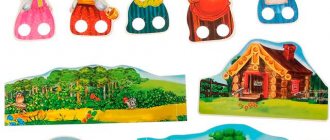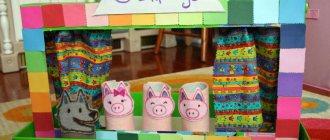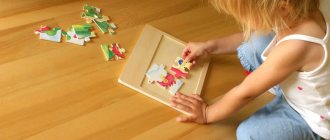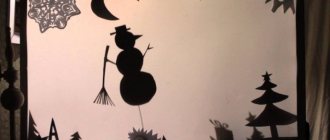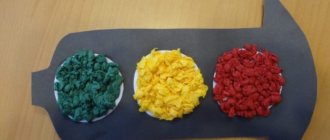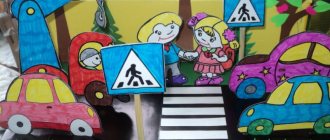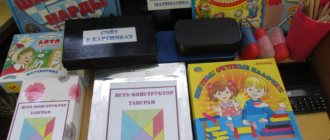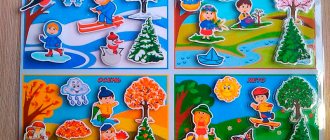MAGAZINE Preschooler.RF
Educational project “Doll on a spoon - theater in the palm of your hand”Authors:
- M.A Maul,
- T.V. Samkharadze,
Educators of GBOU "School No. 2098" in Moscow
“The theater is not at all a trifle and not at all an empty thing. This is the kind of pulpit from which you can say a lot of good to the world.” N.V. Gogol
In modern kindergarten, many types of dolls are used for theatrical activities. However, in order to maintain children’s interest in their native culture and family traditions, intensify cognitive and creative activity and instill moral values and kindness, it is necessary to constantly update the developmental environment of the theater centers (corners) of the kindergarten
To implement the tasks of spiritual and moral education and development of preschool children, dolls-images are needed that contribute to the formation in children of value and semantic ideas about the world, good and evil, and the moral qualities of folk ideals. This idea is revealed in the Concept of spiritual and moral education of the individual citizen of Russia (1), proposing a national educational ideal. For children, such ideals are images of folk tales and epics (2): good fellows, beautiful maidens, heroes, craftsmen and needlewomen, images of a kind mother, a caring and wise priest. By agreement with the parents, these images can be images of Russian saints and images of biblical and gospel subjects.
A doll on a spoon, spoon theater is becoming increasingly popular in the work of preschool organizations. Doll on a spoon, spoon in hand - this principle helps children master puppeteering techniques. The historical roots of the doll on a spoon can be correlated with dolls for nativity theaters with a rod base on which clothes and jewelry were attached. Another advantage of the spoon theater is the wide possibilities of its use for theatrical performances for children from two to seven years old. At four years old, a child can help adults make a doll, and at five years old, he can even make one himself. For this you need a spoon, shreds and ribbons. It is necessary to draw children's attention to the artistic image of the doll, selecting scraps for clothes, developing fine motor skills when dressing up the doll or technical skills in using glue and assembling small parts for the eyes, hair, bows, mouth and nose.
The image of a doll on a spoon should be familiar to children, attractive and loved, only if it will stimulate children's imagination, development and creativity. Such image dolls should be easy to make and necessarily carry a value-semantic educational load. Dolls - actors and actresses should be aesthetically pleasing, bright, light, accessible and safe for children to use.
Highly appreciating the identified pedagogical potential of dolls on spoons, we have developed an educational project “Doll on a spoon - theater in the palm of your hand . Its goal is to develop the child’s personality through theatrical activities, providing conditions for interaction with other types of children’s activities in the holistic pedagogical process. Among the tasks, we will highlight the most important ones.
- Social and communicative development: assimilation of moral norms and values of Russian culture, development of a culture of communication and interaction of the child with adults and peers; development of social and emotional intelligence, emotional responsiveness, empathy, formation of a respectful attitude and a sense of belonging to one’s family and to the community of children and adults; formation of positive attitudes towards various types of work and creativity.
- Cognitive development: acquaintance with a new type of puppet theater - the theater of spoons, development of the ability to play out words with puppets; development of imagination and creative activity, interest in spiritual and moral culture, curiosity and cognitive motivation; formation of cognitive actions; the formation of primary ideas about oneself, other people, objects of the surrounding world, about the small homeland and fatherland, ideas about the socio-cultural values of our people, about domestic traditions and holidays.
- Speech development: enrichment of vocabulary, development of speech culture, including coherent, grammatically correct dialogical and monologue speech, speech creativity, sound and intonation culture of speech, phonemic hearing; acquaintance with book culture and children's literature.
- Artistic and aesthetic development: the formation of an aesthetic attitude towards the surrounding world; formation of elementary ideas about types of art; perception of music, fiction, folklore; formation of prerequisites for value-semantic perception and understanding of works of art (verbal, musical, visual), the natural world; teaching children how to make puppets for the spoon theater, motivating them to play independently with theater puppets and include song and dance improvisations in independent games; stimulating empathy for characters in works of art; implementation of independent creative activities (visual, constructive-model, musical, etc.).
- Physical development: gaining experience in motor activity, developing their physical qualities (coordination and flexibility), developing fine motor skills of both hands, instilling the values of a healthy lifestyle while forming useful habits through the traditions of Russian culture.
The project implements an educational program in forms of activity specific to preschoolers, primarily in the form of play, cognitive and research activities, creative activity that ensures the artistic and aesthetic development of the child. The project involves preparatory group students, teachers, and parents. The project is designed for four months (December, January, February, March). Type of project: educational, game.
Expected results:
- Increasing the competence of educators and other participants in the educational process in developing the abilities and creative potential of each child as a subject of relationships with himself, other children, and the adult world.
- Child development in all areas of educational fields.
- Significant expansion of children's ideas about theatrical culture.
- Increasing the level of general culture of preschool children.
- Creating a subject environment that promotes the development of theatrical culture in children.
- Increasing the level of priority and general recognition in the children's team of the values of humanism, respect for the environment, attitude towards each other, mercy, and readiness to help.
Project stages
The goal of the first, preparatory stage is to determine the level of knowledge about the spoon theater in children and parents. To achieve this goal, we solve the following tasks: create conditions for diagnosis (we develop criteria for assessing knowledge and skills, tests, questionnaires, questionnaires, select methodological literature); we diagnose the primary level of children’s knowledge about puppet theater; we encourage parents to take part in the survey; We select methods for diagnosing the level of children’s creative abilities, including formalized (questionnaire tests) and informal (observations, conversations), we identify the level of creative abilities of each child.
The success of the first stage is facilitated by an emotionally prosperous atmosphere in the kindergarten group. Availability of special pedagogical conditions for the development of children's creativity and subject-development environment.
It is important to draw up a long-term work plan for developing creative abilities in older preschoolers through theatrical games, and conduct a survey of parents “How do you teach goodness?” . We also conduct individual conversations and consultations with parents. Revealing their interest in replenishing the theater corner, as well as opportunities and abilities in a particular area of handicraft.
The second stage involves organizational and pedagogical work aimed at creating conditions for broadening the horizons of children, raising people who love and understand art, striving for theatrical creativity.
Objectives of the main stage: introduce children to the history of the wooden spoon and how to make it; introduce children and parents to puppet theater; introduce children and parents to puppet theater on wooden spoons; tell children about the work of S.Ya. Marshak ( "The Tale of the Stupid Mouse" ), arouse interest in the theatrical production of this tale through a puppet theater on wooden spoons.
For successful work in the second stage, we propose the following plan:
- Lesson No. Journey into the Past of Spoons.” We enrich children's understanding of the history of the spoon.
- Virtual visit to the museum (watching video). We introduce our culture to the past and present. We are designing the album “Museum Stands” .
- Lesson “Oh you spoons, my spoons . We strengthen children's ability to play on spoons, develop a sense of rhythm and hearing. We paint wooden spoons. We introduce children to the arts of Khokhloma painting, develop a sense of color and composition; We create conditions for children's artistic creativity. We listen to folk music performed by the Lozhkari . We teach children to recognize by ear what wooden spoons sound like; We evoke an emotional response to Russian folk melodies. We conduct experiments “Which spoon heats up faster - wooden or metal?” “Which spoon is lighter?”
- Lesson "Puppet theater on a wooden spoon" . We introduce children and parents to a new type of puppet theater, evoke an emotional response and a desire to participate in the performance.
- Knowledge of "Dolls made from wooden spoons" . We teach children to create images of animals using non-standard materials - wooden spoons, pictures of animals; We develop fine motor skills. Master class for parents: we teach different ways to make dolls on a wooden spoon.
- Lesson “Which doll to choose?” . We discuss the characters’ characters, agree on who would like to play what role. We select music for the text. We learn to convey the character, habits and mood of the characters with the help of music. Playing dialogues from a fairy tale. We learn to convey the character of the characters in a fairy tale using facial expressions, gestures, intonation, and voice timbre.
- Rehearsal of a fairy tale with music and decorations. We consolidate puppeteering skills behind a screen.
At the third and final stage, we monitor the project and compare the level of the initial knowledge with the final results. It is important that we diagnose knowledge of theatrical activities in two aspects: theatrical knowledge and skills and personal development, then analyze the data and compare the results. Adding entertainment to the third stage is the exhibition “Do-It-Yourself Puppet Theater on Wooden Spoons ,” an album of photographs with scenes from the play and, of course, a puppet show for parents and kindergarten teachers. We also recommend keeping a book of reviews of performances.
In the process of implementing the project, a significant expansion of children’s knowledge about spiritual and moral culture and the traditions of puppet theater can be observed. Children learned the simplest ways of making theatrical puppets and mastered puppeteering skills. Both children and parents are pleased with the results. By performing sketches with dolls and speaking in front of the audience, students improve their speech culture and enrich its intonation and grammatical structure. Dialogue speech develops significantly. The level of children’s general culture has increased through their familiarization with Russian folk culture, the values of humanism, and respect for the world around them.
The pupils also show positive dynamics of personal changes, and the level of communicative development has increased. The project promotes the formation of a sense of empathy, responsibility for one’s actions, responsiveness towards peers, the ability to peacefully resolve conflicts through collective action, interactions with other children and adults. Thanks to joint activities during the implementation of the project, relationships between children, teachers, and parents were strengthened. Children have become more sociable, relaxed, confident in themselves and their abilities, and are not afraid to speak in front of audiences.
In the parents, we found support not only in the preparatory work (making scenery, attributes of dolls on wooden spoons), but also saw in them talented directors, artists, and teachers of their children.
Literature
- Danilyuk A.Ya., Kondakov A.M., Tishkov V.A. The concept of spiritual and moral development and education of the personality of a Russian citizen. M., 2009.
- Nesterenko A.V. Ethno-artistic education of children and adolescents based on Russian traditional culture. M., 2008.
| Next > |
Theater in your pocket
We do it with dad
Have you ever eavesdropped on children playing? If yes, then you know that children are amazingly artistic creatures. Mom’s and dad’s intonations are easily distinguishable, scenes from everyday life are recognizable... Transformation is a child’s second nature. He tries on different roles and plays them brilliantly. Inspire a young actor to experiment creatively and give him a puppet theater!
As always, we will use available materials, and the little artist himself will participate in the creation of his own theater.
Dolls made from... spoons
Bright and unusual theatrical dolls can be made from disposable spoons in half an hour. By the way, such toys are an ancient tradition; our ancestors painted and even decorated wooden spoons.
You can choose a fairy tale to make a doll set especially for. For example, the fairy tale “Turnip”.
You will need:
• disposable spoons (10-20 pieces); • hot gun and glue; • scissors; • markers; • yarn of different colors; • accessories (buttons, beads, small parts).
First you need to think through the details for each doll.
For grandfather, for example, you can use gray yarn to make hair, eyebrows and mustaches, a large bead for the nose, dark fabric for clothes. You can simply draw the eyes with a marker or glue store-bought ones.
To make doll hair, wind the threads around two fingers, remove the skein and tie it in the middle with thread of the same color. Cut the loops, trim the ends. Apply hot glue to the back (in this case concave) side of the spoon and glue on a bunch of threads. We also glue on the mustache and nose.
Grandfather has a double body - a second spoon is glued to the base spoon, masking the underside. To do this, drop glue onto the top of the cutting and connect the parts.
Wrap a piece of fabric around the handle of the spoon so that it sits loosely (to add volume to the body). Tie fabric clothing, disguise this place with decorative tape.
To make a hairstyle for your grandmother, you need to wind a thread around your palm, make two bunches, and glue them on the concave side of the spoon on the sides (attachment points are marked with black dots). After the glue has hardened, lift the strands up and tie them in the form of a bun. We wrap long strands around the bun and secure with thread of the same color. (Since the grandmother’s hairstyle is voluminous, the second spoon (the back part) may protrude and lie sloppily.)
A turnip can be made from a spoon and from half a Kinder Surprise box. First you need to cut an oval piece of fabric of such a size that it can easily decorate the front part, and still be enough to overlap the back part and secure it. The fabric is attached from the back (concave) side with hot glue. After all, the turnip head is attached to the spoon.
The turnip may have eyes, a mouth painted with red varnish, and on the top of the turnip’s head there may be a bun decorated with a ribbon.
You can give your granddaughter a more “free” hairstyle, and make the dog’s ears and tongue from the remains of a rubber glove or pieces of fabric.
Cone finger puppets
These dolls are relatively fragile - they cannot be crushed, and their strength is not the same. But cone dolls are very funny and dynamic, because wolves and bears sit right on the tips of children's fingers.
You will need:
• colored paper; • PVA glue; • scissors.
You can also choose which fairy tale heroes to make. For example, “Teremka”: a mouse, a frog, a hare, a fox, a wolf and a mischievous bear.
Cut a circle with a diameter of 13 cm into 4 equal parts. One of these quarters will be the template for the base of the toy. The rest is a different set of details for each character.
The workpiece must be rolled up and glued.
Glue the remaining parts - ears, eyes, whiskers, paws, tails, etc. to the finished body. You can curl your mustache using a pencil or using a scissor blade.
Unsinkable Theater
Finger puppets for playing in the bathroom, which will help not only unleash the creative potential of a toddler, but also develop hand motor skills, can be easily made from household rubber gloves.
You will need:
• medium-sized rubber gloves (one pair); • new balloons of different colors (2-3 pieces); • Super glue; • scissors; • marker; • beads, buttons or something similar.
Cut off the fingers from the gloves, and to make it neat, make a curly cut, decorating it with teeth. First, make cuts in one direction, then use scissors to meet these cuts to create corners.
Even if you use a simple marker and just draw faces and muzzles on the dolls, it will turn out great. The marker does not wash off in water. If you have 2-3 colors, the dolls will be bright and expressive.
You can make the “artists” three-dimensional. For this you will need balloons and beads. And before gluing the parts, do not forget to degrease the surfaces.
By the way, in addition to the bathroom, finger puppets can ride with you in the car, visit the clinic, and go to the beach.


